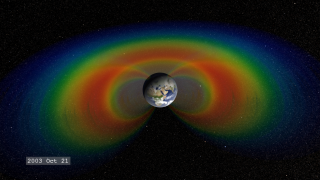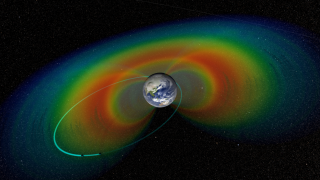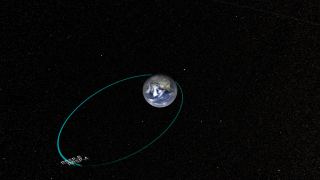Earth's Radiation Belts (cross-section)
The Earth's magnetosphere is a very large magnetic structure around the Earth, and gets stretched into a large, teardrop-shaped configuration through its interaction with the solar wind. A number of the magnetic field lines, while they may originate on the Earth, do not connect back to the Earth, but connect into the magnetic field carried by the solar wind. However, near the Earth, the dipole component of the field is stronger than the solar wind field, and this allows all the magnetic field lines to connect back to the Earth, forming (approximately) the classic magnetic dipole configuration. In this region, lower energy electrons and ions, many from the Earth's ionosphere, can become trapped by the magnetic field to form the radiation belts.
The radiation belt model is constructed from particle flux information from the SAMPEX mission, with the flux mapped to constant L-shells of the Earth's dipole magnetic field. The model is anchored to the Earth's geomagnetic field axis, which is not perfectly aligned with the Earth's rotation axis. This creates a small wobble of the radiation belts with time, which can be seen in this visualization.
The data driving the radiation belt structure is time-shifted from the 2003 Halloween solar storms, a series of strong solar eruptions that began in late October 2003 and continued into the first week of November. During this time, the particle content of the belts change rapidly due to the variation in the energetic particle flux from the Sun buffeting the Earth's magnetosphere.
Related
Visualization Credits
Scott Wiessinger (USRA): Producer
Genna Duberstein (USRA): Producer
David G. Sibeck (NASA/GSFC): Scientist
Shrikanth G. Kanekal (NASA/GSFC): Scientist
NASA/Goddard Space Flight Center Scientific Visualization Studio
https://svs.gsfc.nasa.gov/3950
Missions:
Radiation Belt Storm Probes/Van Allen Probes - RBSP
Solar Anomalous and Magnetospherice Particle Explorer (SAMPEX)
Data Used:
Solar Anomalous and Magnetospheric Particle Explorer (SAMPEX)/HILT
2003/10/17 - 2003/12/25This item is part of this series:
Radiation Belt Storm Probe (RBSP) Pre-Launch
Keywords:
SVS >> Geomagnetic Field
SVS >> HDTV
SVS >> Magnetic Fields
SVS >> Magnetosphere
GCMD >> Earth Science >> Sun-earth Interactions
SVS >> Radiation Belts
SVS >> Space Weather
SVS >> Heliophysics
NASA Science >> Earth
NASA Science >> Sun
SVS >> RBSP
GCMD keywords can be found on the Internet with the following citation: Olsen, L.M., G. Major, K. Shein, J. Scialdone, S. Ritz, T. Stevens, M. Morahan, A. Aleman, R. Vogel, S. Leicester, H. Weir, M. Meaux, S. Grebas, C.Solomon, M. Holland, T. Northcutt, R. A. Restrepo, R. Bilodeau, 2013. NASA/Global Change Master Directory (GCMD) Earth Science Keywords. Version 8.0.0.0.0















